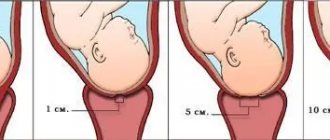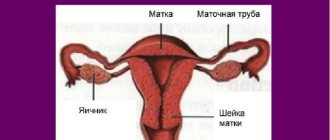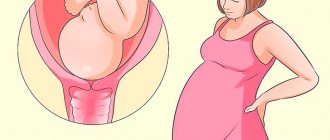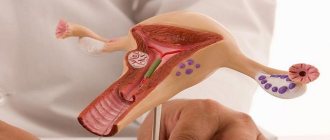List of indications for stimulation of labor
Childbirth is a natural process that is normally provided independently by the reproductive system. Despite this condition, it is impossible to exclude the possibility of pathologies and complications. In some cases, signs of uterine maturity may be absent despite the estimated date of birth having passed, then doctors consider the possibility of post-term pregnancy. This condition is dangerous for the mother and fetus, which in such conditions faces hypoxia.
Stimulation is used to identify medical indications, namely:
- post-term pregnancy confirmed by ultrasound results;
- absence of contractions within 24 hours after the rupture of amniotic fluid;
- acute kidney diseases;
- diabetes;
- polyhydramnios;
- multiple pregnancy;
- cardiac dysfunction in the mother;
- preeclampsia.
Attention! Many of the listed indications for stimulation are contraindications to the use of the drug Mifepristone. The product should not be used for pathologies of the kidneys and heart in women.
In some cases, a woman can independently insist on labor with stimulation, but the decision is made by the doctor. Often, women in labor believe that drug support can make the process less painful and longer, but such a judgment is erroneous. In some cases, due to violations of the labor management protocol during weak labor, extremely painful contractions occur or internal and external ruptures occur.
Nature has it in such a way that a woman is able to give birth on her own, without drug stimulation, and in most cases this is the safest option for her and the child. The use of special drugs is justified only in extreme cases. In other situations, there is a high probability of side effects and complications, therefore, before using the method, you need to weigh the harm and the expected benefit.
Criteria for immaturity
Drug stimulation is used for women in labor who have no contraindications to the use of tablets. Mifepristone is a serious drug whose effects can be unpredictable, so it is prohibited to use it on your own. The drug is used only under medical supervision. Before prescribing the drug, the doctor examines the patient and determines the advisability of labor stimulation.
The condition of the cervix is assessed according to the following criteria:
- neck shape;
- dimensions;
- consistency;
- length;
- degree of disclosure.
The dilation of the cervix is determined in centimeters; complete, ensuring the smooth passage of the child through the birth canal is 10 cm. Maturity is an important criterion. Before childbirth, the structure of the cervix changes, it becomes soft. And its length does not exceed 2 cm. Before labor begins, the cervical canal should be located in the center of the small pelvis. The listed indicators are assessed in points on a scale from 0 to 2. In this case, 0 indicates immaturity according to a certain criterion, and 2 points confirm readiness for childbirth.
Attention! Immaturity of the cervix is more often diagnosed in primiparous women; with repeated births, the risk of such a pathology is minimized, and the risk of precipitate labor increases.
How is the gestational age determined and is there a possibility of error?
There are several methods to determine the EDA (estimated date of birth):
- Calculation of obstetric term. The date is determined from the last menstruation and is subtracted by 3 months. If the last bleeding was on May 14, then the PDR is set on February 14. The method has a high error.
- Gynecological examination. The doctor can determine the gestational age by assessing the condition of the cervix and the size of the reproductive organ. This method is effective in the early stages of pregnancy and is completely inapplicable in the 2-3 trimester, because the process of fetal development at this time is quite unique.
- By date of ovulation. The method allows you to determine the gestational age with an accuracy of several weeks. Most often, ovulation occurs in the middle of the menstrual cycle, but there is an error.
- Ultrasonography. When conducting a study at 11-13 weeks, the doctor can determine the PDR with an accuracy of several weeks. At later stages, the accuracy of the study decreases.
- At the first movement of the fetus. Before the invention of hardware research, this technique was the most relevant, but now it is considered primitive. The method involves carefully monitoring the movements of the fetus. As a rule, the mother feels noticeable tremors at 18-20 weeks; another 20 weeks should be added to this period.
The expected due date is also determined by ultrasound in the 3rd trimester of pregnancy. Diagnostics makes it possible to determine the position of the child’s head in relation to the pelvis, the degree of cervical dilatation, fetal maturity, and the condition of the placenta. The listed parameters are decisive in determining the date of birth.
Women should understand that it is possible to clearly determine the due date in no more than 20% of cases. Normally, labor begins between 39 and 42 weeks. If the process does not begin on its own, they resort to stimulation. One possible method is the use of the drug Mifepristone.
Preparations to prepare the cervix for childbirth in
Any pregnant woman awaits childbirth with impatience and some apprehension. And this is not surprising. After all, without exception, all expectant mothers want the birth of their baby to take place without any unpleasant incidents or complications.
Did you know that the successful outcome of childbirth largely depends not only on how qualified the medical staff is and how equipped the maternity hospital is, but also on the individual characteristics of each woman’s body.
And it depends on how prepared the expectant mother herself is for the birth of a child.
Among everything else, not the least important is the preparation of the cervix for childbirth, carried out in the last months of pregnancy. Moreover, we are talking not only about the preparation of the cervix, which is prescribed by doctors for medical reasons, in the event that it is not ready for childbirth by the 38th week of pregnancy.
Independent preventive preparation is very important and necessary, which allows you to avoid possible cervical ruptures during childbirth.
We will tell you about both types of preparation, but remember that the use of any medications to prepare the uterus for childbirth without a doctor’s prescription is simply unacceptable.
Drug stimulation of cervical ripening
- Use of antispasmodic drugs
Sometimes the cervix does not ripen due to excessive muscle tension.
Therefore, very often, two weeks before the expected date of birth, doctors prescribe various antispasmodics to a woman - for example, no-shpu or papaverine.
The drugs can be administered either intramuscularly or in the form of tablets and rectal suppositories. Only your doctor will determine which drug you need.
In some cases, a woman may be prescribed various drugs containing prostaglandins to be injected into the cervical canal. They significantly contribute to the speedy ripening of the cervix. In some cases, the expectant mother may also be advised to introduce kelp into the cervix - but this procedure is performed exclusively in a hospital setting.
Sometimes doctors do without pharmacological drugs - either with cervical massage, or with nipple stimulation, or with acupuncture. The method is selected individually, taking into account the characteristics of the expectant mother’s body and the nature of the pregnancy.
Preparing the cervix at home
Let's cover the topic a little wider and talk about how you can prepare not only the cervix, but also the entire perineum for childbirth. This will facilitate the birth process itself: reduce it in time and avoid possible perineal ruptures.
Such preparation does not require too much time or much effort from a woman.
But, nevertheless, the result exceeds all expectations - observations of obstetricians indicate that in those women who carry out this training, various complications occur 60% less often than in those who neglected them.
Moreover, all this is explained very simply - frictions are a good massage that prepares the walls of the vagina for significant stretching during childbirth. During orgasm, the muscles of the walls of the uterus and its cervix are trained. By the way, orgasm can become a trigger for the onset of labor - a kind of natural stimulation.
Although, in fairness, it should be noted that this will only happen if both the mother’s body and the baby’s body are physiologically ready for childbirth. Therefore, you can also have sex until the last month of pregnancy. Of course, if there is no threat of premature birth.
It’s not for nothing that in some cases, during a complicated pregnancy, doctors impose a strict ban on sexual activity. And in milder cases, the use of condoms is prescribed, which prevent sperm from entering the cervix and, as a result, prevent its premature ripening.
Please note one more important point - you do not need to use condoms. Sperm contains huge amounts of the natural hormone prostaglandin.
Remember, we already learned that it is this hormone that is responsible for the ripening of the cervix? That is why it is so important that sexual intercourse ends with ejaculation in the woman’s vagina.
However, it goes without saying that the man must be completely healthy - a woman preparing to become a mother has absolutely no need for infections. We hope that such a question cannot arise in your family, but it is still necessary to remember this.
Often, many future dads, hearing such a proposal from their wife, become extremely frightened. And this fear is completely natural - they are simply afraid of harming the woman and baby. Therefore, be sure to talk to your husband and explain that if basic caution is observed and the correct position is selected, there will be absolutely no harm. But the benefits are very difficult to overestimate.
In addition, it is recommended to use evening primrose oil to prepare the uterus for childbirth. You can buy it at almost any pharmacy, without a doctor's prescription. Starting from the 36th week, the expectant mother should drink one capsule per day - but no more! And starting from the 38th week - two capsules.
Capsules should be taken half an hour before meals with plenty of water. The effect of this drug is based on the fact that primrose oil is extremely rich in fatty acids.
And fatty acids, in turn, very intensively provoke the production of prostaglandin, which ensures timely ripening of the cervix.
However, remember that before using this remedy, you must consult a gynecologist.
Source: https://ginekologiya-urologiya.ru/preparaty/preparaty-dlya-podgotovki-shejki-matki-k-rodam-v
What is Mifepristone
Mifepristone is an antiprogestogen drug that blocks hormone-sensitive receptors and terminates pregnancy. The drug is used to induce labor in women at the end of the third trimester. In gynecological practice, the drug is also used to provoke miscarriage in the early stages. Mifepristone reduces the amount of progesterone produced and ensures the separation of the fertilized egg from the uterine wall. Mifepristone is used to prepare for natural childbirth only if indicated.
The instructions for use of the drug also recommend the use of a similar composition as a means of emergency contraception. The composition is used if sexual intercourse was unprotected and pregnancy is unwanted.
Attention! The drug is not a means of contraception; it can be used only in extreme cases, no more than 2-3 times a year. Constant use is dangerous and can cause problems with the endocrine and cardiovascular systems.
When does the pill take effect?
Most often, a woman is recommended to take the drug in the morning on an empty stomach, and the next day the patient takes another tablet. The composition shows activity immediately; in many women in labor, signs of maturity appear on the first day after taking it. Typically, labor will begin within 24 hours, but there are exceptions.
It is worth noting that the drug acts only on the cervix, but does not provoke contractions that ensure sufficient expansion of the cervical canal. For this purpose, the woman in labor is pierced through the amniotic sac. If such actions are not enough, oxytocin is administered during contractions that are not intense.
What actions are taken if the pill is ineffective?
The decision on further actions is made by the gynecologist. If the cervix is amenable to medication, other methods are used to ensure natural delivery. It is advisable to use gels containing prostaglandins and kelp sticks. Similar methods are used if the condition of the woman and fetus is stable; if the indicators worsen, indications for a cesarean section are determined.
Contraindications for use
The list of contraindications to the use of this medication includes:
- intolerance of individual components of the drug by the woman’s body;
- somatic diseases of the woman in labor occurring in the stage of decompensation;
- breech presentation of the fetus;
- placental insufficiency;
- the presence of a scar on the mother’s uterus;
- acute toxicosis, which manifests itself in a woman in the 3rd trimester;
- high blood pressure;
- kidney dysfunction;
- heart diseases;
- a fetus weighing more than 4.5 kg or multiple pregnancy.
Attention! Using the drug if contraindications are identified is strictly prohibited. The consequences for a woman’s body can be irreversible.
Preparing the cervix for childbirth: a review of medications and necessary measures - Supermama
Before labor begins, changes occur in a woman’s body that prepare the birth canal. They depend on hormonal levels and health status.
Sometimes, during a full-term pregnancy, the cervix is not ready for the birth of a child. There is a risk of post-term pregnancy.
In such cases, it is necessary to prepare the cervical canal for childbirth and induce labor.
Features before childbirth
A few days before birth, the cervix matures - changes that allow it to open as the baby passes through and form the birth canal with the vagina.
To determine maturity, pay attention to its location in the pelvis, degree of softness and length. The ability to pass the doctor’s finger during a vaginal examination is also taken into account.
Throughout pregnancy, the cervix is closed and is a dense muscular tube. But gradually its tissues become soft, doughy consistency.
The fetus descends into the pelvis, presses on the isthmus, and the cervix shortens. By birth, it should be located in the center, and the length is about 1 cm.
Even in nulliparous women, the cervical canal allows 1-2 fingers of the doctor to pass through and is easily stretchable. By this time, most women have lost their mucus plug.
The readiness of the cervix for childbirth is assessed using a special scale. A score of 5 points or higher indicates readiness for childbirth. If the readings are lower, the doctor may decide to carry out special preparation for disclosure.
Methods to accelerate maturation used in the maternity hospital
To use preparation methods, it is necessary that the pregnancy is full-term (about 39-40 weeks), and the process of maturation of the birth canal is not observed. But in some cases, a decision may be made to induce labor early. Indications include extragenital diseases of the mother, complications of pregnancy and serious condition of the fetus.
To prepare the cervix for childbirth, mechanical gradual stretching methods, as well as medications, are used. The choice of the appropriate method remains with the doctor, who assesses the patient’s condition.
Mechanical methods
The cervix is formed by smooth muscles that can stretch. Therefore, mechanical action on them and gradual expansion are possible. For this, kelp sticks and a Foley catheter are used.
Kelp sticks
The sticks are made from the stem of kelp seaweed. Their length in a dried state is 5-6 cm, and their thickness is about 1-2 cm. They are inserted as deep as possible into the cervical canal so that small pieces of laminaria protrude from the external pharynx.
Due to the absorption of cervical mucus, they gradually swell, increase in transverse size by 3-4 times and contribute to the stretching of smooth muscles. In addition to mechanical stretching, kelp stimulates the local production of prostaglandins due to the presence of arachidonic acid.
Therefore, the expansion of the cervical canal occurs gradually and gently. This can cause unpleasant sensations that can interfere with your well-being.
Set of kelp sticks “Juno”
The entire process of using kelp is controlled by a doctor. The woman in labor is examined daily, and if necessary, additional sticks can be inserted into the cervical canal. The positive side of the method is the lack of influence on maternal blood pressure and fetoplacental blood flow.
The use of kelp has contraindications. You cannot install sticks if you have cervicitis or colpitis. The infection can penetrate the uterine cavity and lead to infection of the fetus. Therefore, vaginal sanitation is first necessary. You can use candles for this, because... tablets have a systemic effect and can cross the placenta.
Foley catheter
Preparation with a Foley catheter is used less frequently. This procedure can be unpleasant and painful, and the catheter often falls out of the cervical canal. It also does not stimulate the production of prostaglandins, so after removal the cervix can return to its original state.
The catheter is a tube with a balloon that can expand from the liquid introduced into it. The smooth surface makes it easier to insert and does not allow bacteria to multiply. The catheter has different sizes and is available in different models:
- two-way;
- two-way female;
- three-way.
Initially, the Foley catheter was used only as a urological device in the postoperative period. In obstetric practice, it is used to stimulate labor. For women, a size 18 double-way female catheter is most often recommended, which corresponds to the red color of the pipe. It has a shorter length, which means there is less risk of injury.
Two-way female Foley catheter
Stimulation of maturation of the reproductive tract is carried out for the following indications:
Contraindications to the use of this method:
- inflammatory processes in the cervical canal or vagina;
- obstetric hemorrhage and rupture of membranes;
- placenta previa or low placentation.
The device is installed by a doctor in a maternity hospital. The process itself can be painful. They are also preserved while wearing. Installation of the catheter begins with treating the vagina with antiseptics. The cervix is fixed with a clamp. The tip of the catheter is inserted as deep as possible so that the balloon is behind the internal os.
Using a syringe into which 10 ml of sterile sodium chloride solution is drawn, the balloon is expanded. It swells and mechanically puts pressure on the uterus. This leads to accelerated cervical ripening and stimulates uterine contractions.
To prevent the catheter tube from interfering with walking, it is secured with an adhesive tape to the inside of the thigh. Labor should begin within the next 24 hours. If this does not happen, they resort to medicinal methods of stimulation.
As soon as contractions begin (we described how to recognize them in a separate article), the catheter is removed.
During hygiene procedures, it is necessary to ensure that the catheter does not fall out. The device itself should not be touched with unwashed hands to avoid infection. During the period of stimulation, it is necessary to wear cotton loose underwear that does not restrict movement.
Medications
Prostaglandin E2 is produced in the fetal part of the placenta, cervical tissues and in the fetal body. Its amount increases gradually with the aging of the placenta. Prostaglandin can cause softening of the cervix and thereby stimulate its ripening. It also relaxes the isthmus and lower segment of the uterus. Its accumulation in tissues leads to the development of labor.
Prepidil intracervical gel
The synthesis of the substance is stimulated by the fetal hypothalamic-pituitary system. Before childbirth, its active maturation occurs, the activity of the adrenal glands, which synthesize cortisol, is stimulated. Under the influence of this hormone, prostaglandin production also increases.
Medical preparation of the cervix for childbirth includes the introduction of prostaglandins into the vagina or cervical canal. There are absolute contraindications to this procedure:
- epilepsy;
- bronchial asthma;
- arterial hypertension;
- glaucoma;
- insufficiency of liver and kidney function;
- pathology of the cardiovascular system.
The drugs can be inserted into the vagina or used as a solution for intravenous drips. Local means of preparing the cervix for childbirth include Prostin and Prepidil gel. These substances cause smooth muscle maturation, but sometimes spontaneous labor occurs.
After a single injection, the condition of the birth canal is assessed. If progress does not increase, the drug is re-administered after 6 hours. Three-time use of the drug is allowed. Stimulation occurs under the control of blood pressure and fetal condition.
Antigestagens
In rare cases, Mifepristone (trade analogue Miropriston) is used for stimulation. These drugs belong to the group of antigestagens. They block progesterone receptors and stimulate the production of interleukin-8, which increases the sensitivity of the myometrium to prostaglandins. This stimulates the onset of labor. The tablets are taken in a maternity hospital under the supervision of a doctor.
Antigestagen Miropriston
Methods of stimulation with Mifepristone are not used for severe gestosis, preeclampsia, eclampsia, premature pregnancy, fibroids. Care must be taken when choosing dosage. Otherwise, in case of overdose, adrenal insufficiency may develop.
- Mifepristone is used with caution in women with bronchial asthma, liver and kidney pathologies, bleeding disorders, and anemia.
- Nonsteroidal anti-inflammatory drugs should not be taken at the same time; they reduce the effectiveness of the drug.
- Women who have undergone stimulation with this drug are advised to refrain from breastfeeding for 14 days after birth.
For patients with artificial valves and endocarditis, antibacterial agents are prescribed for prevention. Sometimes side effects develop in the form of dizziness, nausea, vomiting, diarrhea, and fever.
Antispasmodics
In some cases, antispasmodics are used to prepare the cervix for childbirth: No-shpa (Drotaverine), Buscopan suppositories, Papaverine, which are placed in the rectum at night.
Antispasmodics
Antispasmodics are not as active, but they are relatively safe for the mother and fetus. They are also used during childbirth to reduce pain when the uterus dilates.
Preparing the cervix for childbirth at home
Some pregnant women practice independent preparation for childbirth. Not all methods can be safe. They should not be used when:
- bleeding that occurred during gestation;
- partial or complete placenta previa;
- fetoplacental insufficiency;
- fetal pathologies.
For patients in satisfactory health, without pregnancy pathologies, doctors recommend having sex without using contraceptives.
Male sperm contains prostaglandins, which can accelerate the ripening of the cervix and soften it. During sex, the vaginal walls stretch and blood flow increases.
Orgasm can also stimulate training contractions, which will prepare the birth canal.
The method should not be practiced in the case of a sexually transmitted infection in a spouse or a mucous plug that has come off. This increases the risk of infection of the fetus, which will worsen the course of the postpartum period and may cause postpartum endometritis.
Nipple massage can help stimulate uterine contractions, which cause the cervix to shorten and smooth out. Their irritation leads to the release of oxytocin, which affects the myometrium and causes its contraction. The consequence is gradual maturation of the cervix.
Fatty acids improve the condition of the cervix. They are found in accessible form in fish, so it is recommended to increase its amount in the diet in the last stages of gestation.
If there are no contraindications, your doctor may recommend taking evening primrose oil. It can be used after 37 weeks of gestation. The fatty acids contained in the drug also promote the production of prostaglandins.
For stimulation, herbs are used in the form of decoctions and infusions. Raspberry leaves, strawberry decoction, water infusion of rose hips and hawthorn help. But the effectiveness of traditional medicine methods has not been proven. The listed plants are not considered dangerous, so they will not cause harm to either the fetus or the mother.
Natural maturation of the birth canal occurs with increased physical activity. This method must be approached with caution. Usually these are moderate loads that are associated with everyday housework.
Methods of preparing the birth canal are chosen depending on the condition of the woman in labor.
If the above methods are ineffective, the cervix does not ripen during full-term and post-term pregnancy, an indication for delivery by cesarean section may arise.
Further stimulation of labor with oxytocin can provoke violent labor, and if the birth canal is unprepared, this will lead to labor anomalies and many complications from the mother or fetus.
Article on the topic: Stimulation of labor.
Source:
Preparing the cervix for childbirth - effective means
Your expected due date is approaching. Thoughts about this can bring fear to the expectant mother. How will this process go? Will she cope? How to make childbirth as painless as possible and avoid ruptures? We will try to answer the last question in this article.
Preparing the uterus for childbirth
The 38th week of pregnancy is the time when the body begins to actively prepare for childbirth. By this time, the cervix should be mature, becoming shorter and more elastic. These are the optimal conditions for the baby to be born.
By 38 weeks, the cervix is not always mature and ready for childbirth. This can happen for the following reasons:
- Post-term pregnancy;
- For medical reasons, there is a need to advance labor;
- The onset of labor despite the unpreparedness of the birth canal and uterus.
If the doctor sees the need for procedures to prepare the uterus for childbirth, he will discuss this issue with the pregnant woman and give related recommendations.
The characteristics of her body and the course of pregnancy will be taken into account. And only on the basis of this data will he be able to select the necessary manipulations.
Source: https://3rdom74.ru/zdorove/podgotovka-shejki-matki-k-rodam-obzor-preparatov-i-neobhodimyh-mer.html
Consequences of using the drug
The likelihood of side effects when using the drug under the supervision of an obstetrician-gynecologist is minimized, but it is impossible to completely eliminate such a risk. According to the instructions for use, Mifepristone can cause:
- bleeding after childbirth;
- cramps in the abdominal area;
- diarrhea and nausea;
- weaknesses;
- severe headache;
- allergic reactions.
This method of induction of labor cannot be called the most effective, but in comparison with the mechanical one, it is considered less painful for first-time women. In 80% of cases, the substance allows you to prepare and soften the cervix for childbirth, but sometimes ripening does not occur and doctors use additional methods.











